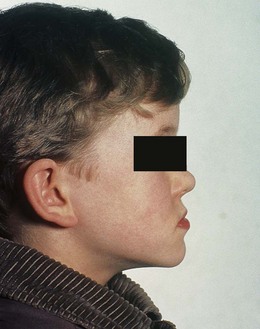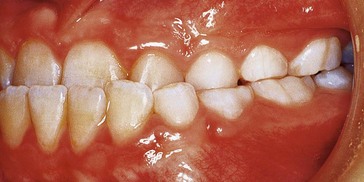11 Reverse overjet
Summary
Alistair, 8.5 years old, presents with a reverse overjet on all of his upper incisors (Fig. 11.1). What is the cause and how may it be treated?
Examination
Extraoral
Alistair has a mild Class III skeletal pattern with average FMPA (Fig. 11.2) and no facial asymmetry.
Intraoral
 What are your observations from the intraoral views (Figs 11.1 and 11.3)?
What are your observations from the intraoral views (Figs 11.1 and 11.3)?
The soft tissues appear healthy with the exception of mild marginal gingival erythema related to the incisor teeth. Oral hygiene is fair. The dentition appears caries free. 6 e d c 2 1 are present in each quadrant.
 What are the possible causes of the reverse overjet?
What are the possible causes of the reverse overjet?
| Cause | Aetiology |
|---|---|
| Skeletal | Usually Class III due to any of the following: long mandible, forward placement of glenoid fossa positioning the mandible more anteriorly; short and/or retrognathic maxilla; short anterior cranial base |
| Anterior mandibular displacement on closure | A premature contact may displace the mandible forward on closure into maximum interdigitation |
| Retained primary upper incisors | These may deflect the eruption path of their successors palatally into crossbite |
| Pattern/excessive mandibular growth | Forward pattern of mandibular growth will exacerbate a Class III skeletal pattern |
| Excessive mandibular growth may be due to excess growth hormone resulting from a pituitary adenoma | |
| Restraint of maxillary growth | Found in repaired cleft lip and palate and attributed to the effect of post-surgical scar tissue |
 What radiographic investigations would you request and why?
What radiographic investigations would you request and why?
A dental panoramic tomogram would be required to account for the presence and position of all the remaining permanent teeth.
A lateral cephalometric radiograph is indicated to assess more accurately the magnitude of the Class III skeletal pattern and the incisor angulations, which will facilitate treatment planning. It will also form a baseline from which treatment progress/growth changes can be evaluated by comparison with future cephalometric films.
Stay updated, free dental videos. Join our Telegram channel

VIDEdental - Online dental courses





 was detected from RCP to ICP. No temporomandibular joint signs were noted and Alistair reported no temporomandibular joint symptoms. There was no masticatory muscle tenderness.
was detected from RCP to ICP. No temporomandibular joint signs were noted and Alistair reported no temporomandibular joint symptoms. There was no masticatory muscle tenderness.

